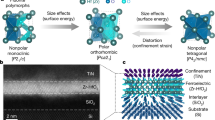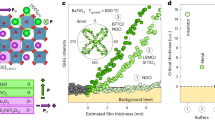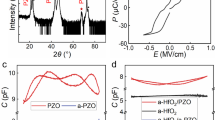Abstract
The integration of ferroelectric oxide films into microelectronic devices1,2, combined with the size reduction constraints imposed by the semiconductor industry, have revived interest in the old question concerning the possible existence of a critical thickness for ferroelectricity. Current experimental techniques have allowed the detection of ferroelectricity in perovskite films down to a thickness of 40 Å (ten unit cells), ref. 3. Recent atomistic simulations4,5 have confirmed the possibility of retaining the ferroelectric ground state at ultralow thicknesses, and suggest the absence of a critical size. Here we report first-principles calculations on a realistic ferroelectric–electrode interface. We show that, contrary to current thought, BaTiO3 thin films between two metallic SrRuO3 electrodes in short circuit lose their ferroelectric properties below a critical thickness of about six unit cells (∼24 Å). A depolarizing electrostatic field, caused by dipoles at the ferroelectric–metal interfaces, is the reason for the disappearance of the ferroelectric instability. Our results suggest the existence of a lower limit for the thickness of useful ferroelectric layers in electronic devices.
This is a preview of subscription content, access via your institution
Access options
Subscribe to this journal
Receive 51 print issues and online access
$199.00 per year
only $3.90 per issue
Buy this article
- Purchase on Springer Link
- Instant access to full article PDF
Prices may be subject to local taxes which are calculated during checkout



Similar content being viewed by others
References
McKee, R. A., Walker, F. J. & Chisholm, M. F. Physical structure and inversion charge at a semiconductor with a crystalline oxide. Science 293, 468–471 (2001)
Tybell, Th., Paruch, P., Giamarchi, T. & Triscone, J.-M. Domain wall creep in epitaxial ferroelectric Pb(Zr0.2Ti0.8)O3 thin films. Phys. Rev. Lett. 89, 097601 (2002)
Tybell, Th., Ahn, C. H. & Triscone, J.-M. Ferroelectricity in thin perovskite films. Appl. Phys. Lett. 75, 856–858 (1999)
Ghosez, Ph. & Rabe, K. M. Microscopic model of ferroelectricity in stress-free PbTiO3 ultrathin films. Appl. Phys. Lett. 76, 2767–2769 (2000)
Meyer, B. & Vanderbilt, D. Ab initio study of BaTiO3 and PbTiO3 surfaces in external electric fields. Phys. Rev. B 63, 205426 (2001)
McKee, R. A., Walker, F. J. & Chisholm, M. F. Crystalline oxides on silicon: the first five monolayers. Phys. Rev. Lett. 81, 3014–3017 (1998)
Ahn, C. H. et al. Local, nonvolatile electronic writing of epitaxial Pb(Zr0.52Ti0.48)O3/SrRuO3 heterostructures. Science 276, 1100–1103 (1997)
Eisenbeiser, K. et al. Field effect transistors with SrTiO3 gate dielectric on Si. Appl. Phys. Lett. 76, 1324–1326 (2000)
Tybell, Th., Ahn, C. H. & Triscone, J.-M. Control and imaging of ferroelectric domains over large areas with nanometer resolution in atomically smooth epitaxial Pb(Zr0.52Ti0.48)O3 thin films. Appl. Phys. Lett. 72, 1454–1456 (1998)
Scott, J. F. & Paz de Araujo, C. A. Ferroelectric memories. Science 246, 1400–1405 (1989)
Lines, M. E. & Glass, A. M. Principles and Applications of Ferroelectrics and Related Materials (Clarendon, Oxford, 1977)
Bune, A. V. et al. Two-dimensional ferroelectric films. Nature 391, 874–877 (1998)
Kohlstedt, H., Pertsev, N. A. & Waser, R. Size effects on polarization in epitaxial ferroelectric films and the concept of ferroelectric tunnel junctions including first results. Mater. Res. Soc. Symp. Proc. 688, C6.5 (2002)
Rao, F., Kim, M., Freeman, A. J., Tang, S. & Anthony, M. Structural and electronic properties of transition-metal/BaTiO3 (001) interfaces. Phys. Rev. B 55, 13953–13960 (1997)
Eom, C. B. et al. Single-crystal epitaxial thin films of the isotopic metallic oxides Sr1-xCaxRuO3 (0 ≤ x ≤ 1). Science 258, 1766–1769 (1992)
Soler, J. M. et al. The SIESTA method for ab initio order-N materials simulations. J. Phys. Condens. Matter 14, 2745–2779 (2002)
Hartmann, A. J., Neilson, M., Lamb, R. N., Watanabe, K. & Scott, J. F. Ruthenium oxide and strontium ruthenate electrodes for ferroelectric thin-film capacitors. Appl. Phys. A 70, 239–242 (2000)
Ahn, C. H. et al. Ferroelectric field effect in ultrathin SrRuO3 films. Appl. Phys. Lett. 70, 206–208 (1997)
Eom, C. B. et al. Fabrication and properties of epitaxial ferroelectric heterostructures with (SrRuO3) isotropic metallic oxide electrodes. Appl. Phys. Lett. 63, 2570–2572 (1993)
Zimmer, M., Junquera, J. & Ghosez, Ph. Ab initio study of metal/ferroelectric and insulator/ferroelectric heterostructures. AIP Conf. Proc. 626, 232–241 (2002)
Neaton, J. B., Hsueh, C. L. & Rabe, K. M. Enhanced polarization in strained BaTiO3 from first principles. Mater. Res. Soc. Symp. Proc. 718, 311 (2002)
Cohen, R. E. Origin of ferroelectricity in perovskite oxides. Nature 358, 136–138 (1992)
Baldereschi, A., Baroni, S. & Resta, R. Band offsets in lattice-matched heterojunctions: a model and first-principles calculations for GaAs/AlAs. Phys. Rev. Lett. 61, 734–737 (1988)
Fu, H. & Cohen, R. E. Polarization rotation mechanism for ultrahigh electromechanical response in single-crystal piezoelectrics. Nature 403, 281–283 (2000)
King-Smith, R. D. & Vanderbilt, D. Theory of polarization of crystalline solids. Phys. Rev. B 47, 1651–1654 (1993)
Bernardini, F. & Fiorentini, V. Electronic dielectric constants of insulators calculated by the polarization method. Phys. Rev. B 58, 15292–15295 (1998)
Mehta, R. R., Silverman, B. D. & Jacobs, J. T. Depolarization fields in thin ferroelectric films. J. Appl. Phys. 44, 3379–3385 (1973)
Chandra, P., Dawber, M., Littlewood, P. B. & Scott, J. F. Thickness-dependence of the coercive field in ferroelectrics. Preprint at 〈http://xxx.lanl.gov/abs/cond-mat/0206014〉 (2002).
Nagaraj, B., Aggarwal, S. & Ramesh, R. Influence of contact electrodes on leakage characteristics in ferroelectric thin films. J. Appl. Phys. 90, 375–382 (2001)
Hwang, C. S. et al. A comparative study on the electrical conduction mechanisms of (Ba0.5Sr0.5)TiO3 thin films on Pt and IrO2 electrodes. J. Appl. Phys. 83, 3703–3713 (1998)
Acknowledgements
We thank Th. Tybell, J.-M. Triscone, H. Kohlstedt, M. Veithen, X. Gonze and D. Vanderbilt for discussions, and K. M. Rabe and A. García for critical reading of the manuscript. This work was supported by the VolkswagenStiftung, the ULg, the FNRS-Belgium, the CGRI, the Fundación Ramón Areces and the Spanish MCyT.
Author information
Authors and Affiliations
Corresponding author
Ethics declarations
Competing interests
The authors declare that they have no competing financial interests.
Rights and permissions
About this article
Cite this article
Junquera, J., Ghosez, P. Critical thickness for ferroelectricity in perovskite ultrathin films. Nature 422, 506–509 (2003). https://doi.org/10.1038/nature01501
Received:
Accepted:
Issue Date:
DOI: https://doi.org/10.1038/nature01501
This article is cited by
-
Candidate ferroelectrics via ab initio high-throughput screening of polar materials
npj Computational Materials (2024)
-
Giant tunnelling electroresistance in atomic-scale ferroelectric tunnel junctions
Nature Communications (2024)
-
Extendable piezo/ferroelectricity in nonstoichiometric 2D transition metal dichalcogenides
Nature Communications (2023)
-
Point-defect-driven flattened polar phonon bands in fluorite ferroelectrics
npj Computational Materials (2023)
-
Absence of critical thickness for polar skyrmions with breaking the Kittel’s law
Nature Communications (2023)
Comments
By submitting a comment you agree to abide by our Terms and Community Guidelines. If you find something abusive or that does not comply with our terms or guidelines please flag it as inappropriate.



